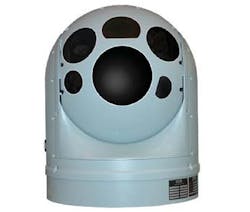Navy orders FLIR Systems electro-optical shipboard sensors for surveillance and fire control
Officials of the Naval Surface Warfare Center in Crane, Ind., are ordering the FLIR Systems Sea Star SAFIRE III and Brite Star II multi-sensor systems for use aboard surface ships and boats.
The contract includes the Sea Star and Brite Star infrared sensor systems, as well as services that cover provision item ordering spares, repairs, field repair, technical assists, travel, training, and data, Navy officials say.
The FLIR BRITE Star II electro-optical system functions as the fire-control system for the Patrol Coastal Griffin missile system. It uses infrared and charge-coupled device (CCD) cameras to detect, identify, and track targets. Brite Star II uses a laser range finder to determine the distance and position of the target and provides terminal guidance to the launched Griffin Missile seeker head with a laser designator. The sensor also includes a diode-pumped laser rangefinder and designator for long range target designation.
The small Griffin missile is fired from a common launch tube and is for Special Forces operations. It measures 43 inches long, weighs 33 pounds, and packs a 13-pound explosive warhead for low collateral damage.
Related: FLIR Systems to design thermal imaging sensors for Navy and Coast Guard patrol boats
The FLIR Sea Star SAFIRE III electro-optical sensor, meanwhile, is a rugged ship-mountable system to provide surface ships with a day and night high-resolution infrared and visible-light imaging and rangefinding capability to augment existing optical and radar sensors to detect and identify asymmetric threats.
The FLIR BRITE Star II multi-sensor targeting system has a five-field-of-view (FOV) large-format thermal imager; three-FOV high-resolution three-chip color daylight camera with matched fields of view to the thermal imager; diode-pumped laser designator and rangefinder; laser pointer; automatic in-flight bore sighting capability; laser spot tracker; inertial measurement unit and navigation processor; and automatic target tracker.
The BRITE Star sensor provides situational awareness; enhances daylight missions and target identification; maintains operator orientation when switching between sensors; is compatible with U.S. and NATO laser-guided munitions such as Hellfire missiles; mark locations and targets for forces equipped with night-vision goggles.
BRITE Star holds track during rigorous maneuvers; has a multi-mode adaptive tracker that locks onto and holds moving and stationary targets independent of platform motion.
Related: FLIR Systems to provide Star Safire 380 thermal imaging systems to Austrian military
The FLIR Sea Star SAFIRE II is for force protection, surveillance, search and rescue, navigation, situational awareness, and video data collection.
It features a high-resolution, 640-by-480-pixel thermal imaging sensor with zoom optics; daylight and low-light CCD-TV sensor with continuous zoom optics, geo stabilization, auto tracker, eye-safe laser rangefinder, and three-field-of-view color spotter scope with haze-penetrating filter.
The system offers high image quality in total darkness; enhances daytime surveillance and data gathering. Its low-light capability extends operations into dawn an dusk. The sensor also provides stable imaging in rough seas or during high-speed maneuvers.
It is engineered to meet MIL-STD-810 for harsh military maritime conditions, and enables the operator to lock onto targets and reduce operator fatigue. The system can communicate with command-and-control systems, GPS and inertial navigation systems, radar, moving maps, and searchlight systems.
Not included in this particular contract is the Patrol Boat Electro-Optics System (PB-EOS), which FLIR Systems is designing for Navy and Coast Guard patrol boats. The primary mission of the PB-EOS is to provide enhanced visual imagery to augment existing electronic sensors.
On this contract for the BRITE Star and Sea Star electro-optical sensors, FLIR Systems will do the work in Wilsonville, Ore., and should be finished by July 2021. For more information contact FLIR Systems online at www.flir.com, or the Naval Surface Warfare Center-Crane at www.navsea.navy.mil/Home/Warfare-Centers/NSWC-Crane.
